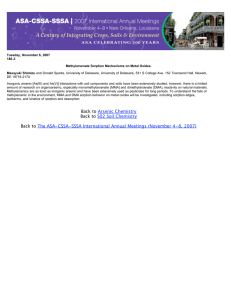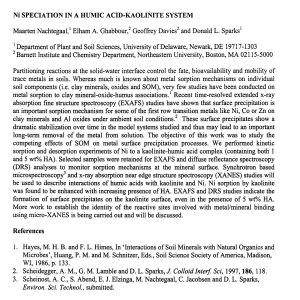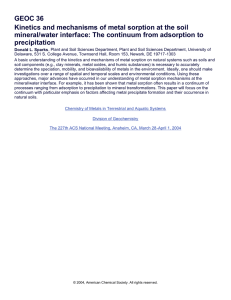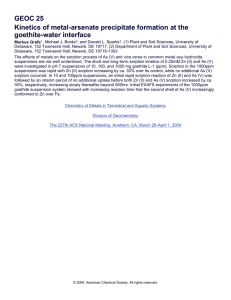G E O C
advertisement
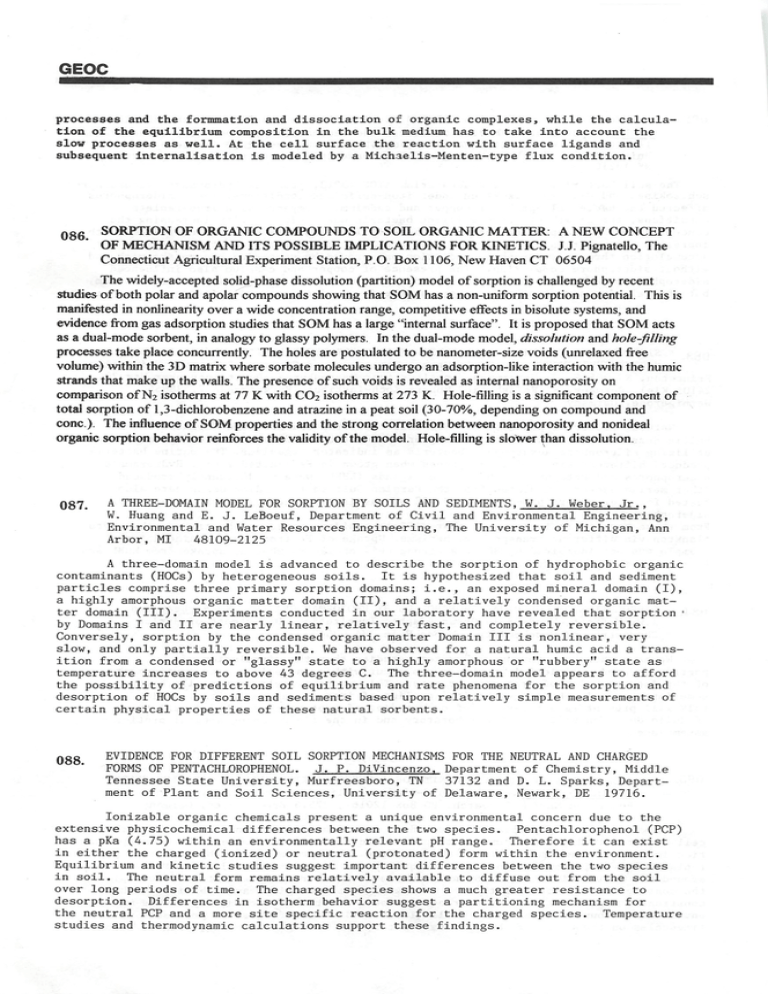
GEOC processes and the fonranation and dissociation of organic complexes, while the calcula tion of the equilibrium composition in the bulk medium has to take into account the slow processes as well. At the cell surface the reaction with surface ligands and s u b s e q u e n t i n t e r n a l i s a t i o n i s m o d e l e d b y a M i c h a e l i s - M e n t e n - t y p e fl u x c o n d i t i o n . Qgg SORPTION OF ORGANIC COMPOUNDS TO SOIL ORGANIC MATTER: A NEW CONCEPT OF MECHANISM AND ITS POSSIBLE IMPLICATIONS FOR KINETICS. J J Pignatello, The Connecticut Agricultural Experiment Station, P.O. Box 1106, New Haven CT 06504 The widely-accepted solid-phase dissolution (partition) model of sorption is challenged by recent studies of both polar and apolar compounds showing that SOM has a non-uniform sorption potential. This is manifested in nonlinearity over a wide concentration range, competitive effects in bisolute systems, and evidence from gas adsorption studies that SOM has a large "internal surface". It is proposed that SOM acts as a dual-mode sorbent, in analogy to glassy polymers. In the dual-mode model, dissolution and hole-filling processes take place concurrently. The holes are postulated to be nanometer-size voids (unrelaxed free volume) within the 3D matrix where sorbate molecules undergo an adsorption-like interaction with the humic strands that make up the walls. The presence of such voids is revealed as internal nanoporosity on comparison of N2 isotherms at 77 K with CO2 isotherms at 273 K. Hole-filling is a significant component of total sorption of 1,3-dichlorobenzene and atrazine in a peat soil (30-70%, depending on compound and conc ). The influence of SOM properties and the strong correlation between nanoporosity and nonideal organic sorption behavior reinforces the validity of the model. Hole-filling is slower than dissolution. 087. A THREE-DOMAIN MODEL FOR SORPTION BY SOILS AND SEDIMENTS. W. J. Weber. Jr.. W. H u a n g a n d E . J . L e B o e u f , D e p a r t m e n t o f C i v i l a n d E n v i r o n m e n t a l E n g i n e e r i n g , En vi ro n me n ta l a n d Water R esources Engi neeri ng, The U n i ve rsi ty o f Mi ch i g a n , An n Arbor, MI 48109-2125 A three-domain model is advanced to describe the sorption of hydrophobic organic contaminants (HOCs) by heterogeneous soils. It is hypothesized that soil and sediment particles comprise three primary sorption domains; i.e., an exposed mineral domain (I), a highly amorphous organic matter domain (II), and a relatively condensed organic mat ter domain (III). Experiments conducted in our laboratory have revealed that sorption ' b y D o m a i n s I a n d I I a r e n e a r l y l i n e a r, r e l a t i v e l y f a s t , a n d c o m p l e t e l y r e v e r s i b l e . C o n v e r s e l y, s o r p t i o n b y t h e c o n d e n s e d o r g a n i c m a t t e r D o m a i n I I I i s n o n l i n e a r, v e r y s l o w, a n d o n l y p a r t i a l l y r e v e r s i b l e . We h a v e o b s e r v e d f o r a n a t u r a l h u m i c a c i d a t r a n s ition from a condensed or "glassy" state to a highly amorphous or "rubbery" state as temperature increases to above 43 degrees C. The three-domain model appears to afford the possibility of predictions of equilibrium and rate phenomena for the sorption and desorption of HOCs by soils and sediments based upon relatively simple measurements of certain physical properties of these natural sorbents. Qgo EVIDENCE FOR DIFFERENT SOIL SORPTION MECHANISMS FOR THE NEUTRAL AND CHARGED F O R M S O F P E N TA C H L O R O P H E N O L . J . P. D i Vi n c e n z o . D e p a r t m e n t o f C h e m i s t r y, M i d d l e Te n n e s s e e S t a t e U n i v e r s i t y , M u r f r e e s b o r o , T N 3 7 1 3 2 a n d D . L . S p a r k s , D e p a r t ment of Plant and Soil Sciences, University of Delaware, Newark, DE 19716. lonizable organic chemicals present a unique environmental concern due to the extensive physicochemical differences between the two species. Pentachlorophenol (PCP) has a pKa (4.75) within an environmentally relevant pH range. Therefore it can exist in either the charged (ionized) or neutral (protonated) form within the environment. Equilibrium and kinetic studies suggest important differences between the two species in soil. The neutral form remains relatively available to diffuse out from the soil over long periods of time. The charged species shows a much greater resistance to desorption. Differences in isotherm behavior suggest a partitioning mechanism for t h e n e u t r a l P C P a n d a m o r e s i t e s p e c i fi c r e a c t i o n f o r t h e c h a r g e d s p e c i e s . Te m p e r a t u r e s t u d i e s a n d t h e r m o d y n a m i c c a l c u l a t i o n s s u p p o r t t h e s e fi n d i n g s .

